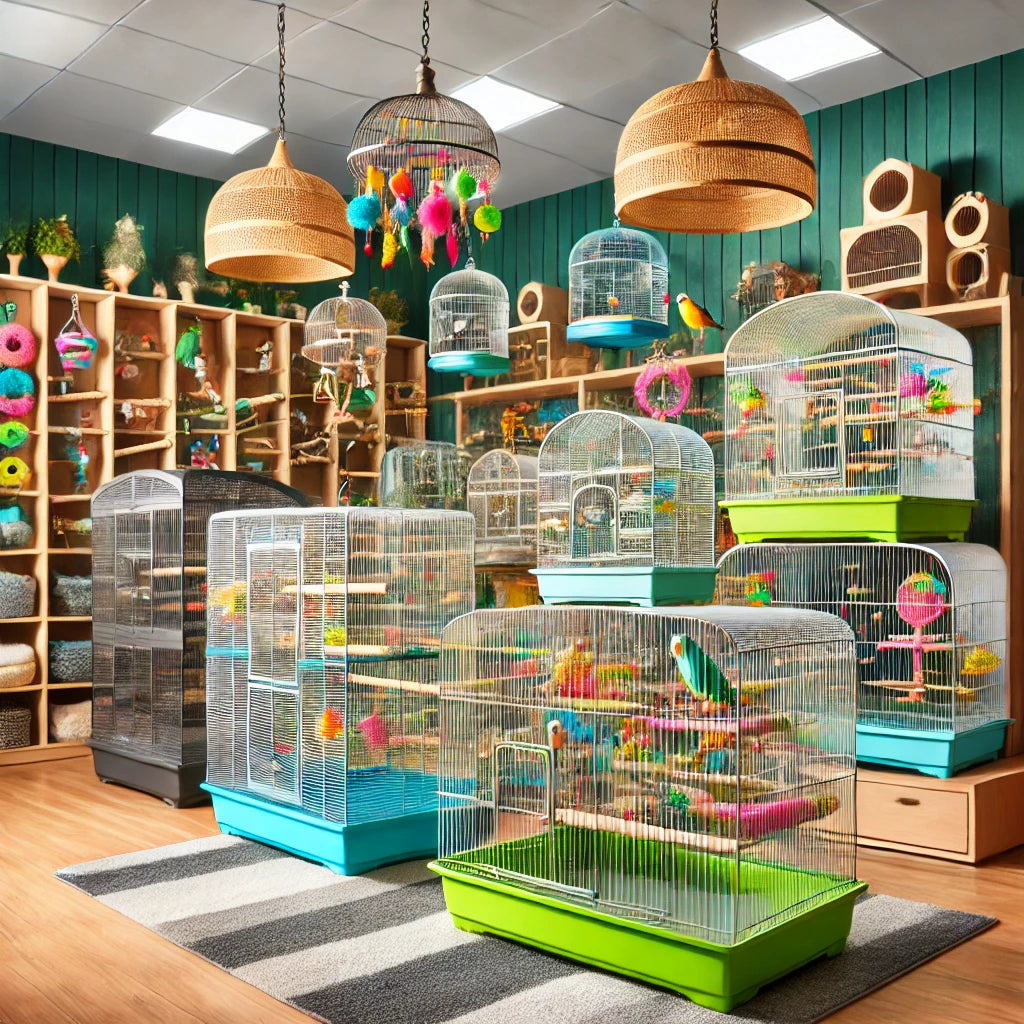
Bird Cages: Finding the Perfect Home for Your Feathered Friends
Share
Are you looking to bring a new bird into your home, or perhaps you want to upgrade your bird’s current cage? A bird cage isn’t just a box; it’s your pet’s home. Choosing the right one can make a world of difference in your bird’s happiness and health. Let’s dive into everything you need to know about bird cages, where to find them near you, and what makes a great cage for your feathered friend.
Why Choosing the Right Bird Cage Matters
Birds aren’t just pets—they’re companions that deserve a comfortable and safe space. A bird cage isn’t just a place to contain them; it’s where they’ll eat, sleep, play, and live. Picking the right cage impacts their:
- Health: The right cage size and materials prevent injury or stress.
- Happiness: A spacious, interactive environment keeps your bird mentally stimulated.
- Longevity: A proper cage contributes to a longer, healthier life.
Types of Bird Cages
Bird cages come in all shapes, sizes, and styles. Understanding your bird’s specific needs is key to finding the perfect one.
Flight Cages
Perfect for birds like finches or canaries that love to fly. These cages are wide and allow for plenty of wing movement.
Playtop Cages
Great for parrots and cockatiels, playtop cages have a built-in play area on top with toys or perches to keep your bird entertained.
Dome-Top Cages
Aesthetic and spacious, these cages have rounded tops that allow for extra height, making them ideal for larger birds like African greys or macaws.
Travel Cages
Portable and lightweight, travel cages are designed for short trips or visits to the vet.
What to Look for in a Bird Cage
Before you head out to buy a cage, here’s what to consider:
Cage Size
Birds need space to stretch their wings and move around. As a rule, bigger is always better. For example:
- Small birds (budgies, canaries): Minimum of 18x18x24 inches.
- Medium birds (cockatiels, conures): Minimum of 24x24x30 inches.
- Large birds (parrots, macaws): Minimum of 36x36x48 inches.
Bar Spacing
Bar spacing should match your bird’s size to prevent escape or injury:
- Small birds: 0.5-inch spacing.
- Medium birds: 0.5–0.75-inch spacing.
- Large birds: 1–1.5-inch spacing.
Material and Durability
Choose a cage made of non-toxic, sturdy materials like stainless steel. Avoid cages with paint or coatings that could chip and harm your bird.
Ease of Cleaning
Look for features like pull-out trays, removable grates, and large doors for easy maintenance.
Safety Features
Ensure there are no sharp edges, loose parts, or small gaps where your bird could get stuck.
Bird Cages Near Me
Finding bird cages near you doesn’t have to be complicated. Here’s where you can start looking:
Local Pet Stores
Big-box retailers like Petco and PetSmart often have a range of cages to choose from. Visit your local store to check the quality in person.
Specialty Bird Shops
Specialty shops focus on birds and often carry higher-quality cages and accessories. They’re a great place to get expert advice.
Online Marketplaces
Websites like Amazon, Chewy, and Wayfair offer a wide selection of bird cages with detailed reviews.
Secondhand Options
Check platforms like Craigslist, Facebook Marketplace, or local thrift stores for budget-friendly used cages. Just be sure to sanitize thoroughly before use!
Setting Up the Perfect Bird Cage
Buying a cage is only the first step. Making it a home for your bird involves adding the right accessories.
Perches
Provide a variety of perch sizes and materials to prevent foot fatigue and mimic a natural environment.
Food and Water Bowls
Choose sturdy, easy-to-clean bowls. Position them where your bird can access them easily but away from perches to prevent droppings.
Toys
Interactive toys keep your bird mentally stimulated. Rotate them regularly to maintain interest.
Cage Liners
Use paper liners or bird-safe bedding for easy cleaning and odor control.
Placement
Place the cage in a well-lit, draft-free area where your bird can feel part of the family without too much noise or activity.
Maintaining Your Bird Cage
Regular maintenance is crucial to keep your bird healthy and your home odor-free.
Daily Tasks
- Remove uneaten food and clean food/water dishes.
- Replace cage liners.
Weekly Tasks
- Wash the entire cage with bird-safe soap and water.
- Disinfect perches and toys.
Monthly Tasks
- Deep clean and inspect the cage for wear and tear.
- Replace worn-out perches or toys.
Final Thoughts
Choosing the right bird cage isn’t just about finding something that fits your budget—it’s about creating a safe, happy space for your feathered friend. By understanding your bird’s needs and investing in quality materials, you’ll give them the best life possible.
FAQs
What is the best cage size for my bird?
The best size depends on your bird’s species. As a rule, always choose the largest cage you can afford and fit in your space.
How often should I clean my bird cage?
Daily cleaning of food and water areas is essential. A thorough wash should be done weekly, with a deep clean monthly.
Can I use a secondhand bird cage?
Yes, but sanitize it thoroughly with bird-safe disinfectant to remove any residue or bacteria from previous use.
Where should I place my bird cage?
Place it in a well-lit, draft-free area, away from direct sunlight, kitchens, or loud areas like TV rooms.
Are wooden bird cages safe?
Wooden cages are not ideal, as they are harder to clean and birds may chew on them, ingesting harmful splinters.